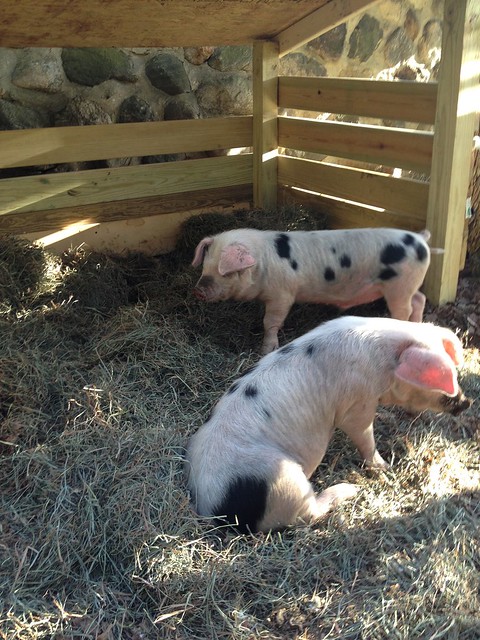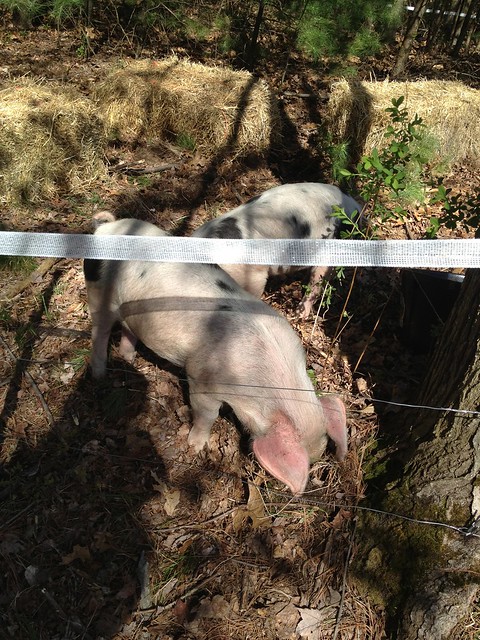Meet our latest project: backyard pigs
/If you had asked me a couple of years ago, I would've told you that we don't really eat that much pork. I mean, sure we have the occasional whole pig roast in our backyard. And lord knows, I am a fan of good bacon. But otherwise, I'd have told you that we eat way less pork than most. We don't even eat that much beef. We're mostly chicken kind of people. That's what I would've said.
Somehow, however, we manage to put up, cure, and otherwise consume two pigs a year. Every year. So last fall, I traded in my amateur card for whatever the next level is, and announced to my family that we would be raising our own pigs in our backyard this year.
My family looked at one another and then my Bride tentatively asked, "Sure, honey. But where will you put them?"
"Behind the barn. I've got it all worked out in my head."
To her credit, she didn't laugh at this.
"Where will you get them?"
"In the spring. They will be small. And then we will feed them, and take them to slaughter, and we will have the pride of knowing we took care of our own food. It'll be a Good Experience™."
"OK. But I asked where you would get them."
"..."
"..."
"Oh."
I didn't know. So I started looking on the internet, just like the settlers did.
Turns out, it's a lot easier to get a pig if you live in, say central Texas, than if you live in a suburb of Boston. Still, I did find a few places within reasonable striking distance. I knew I wasn't going to be happy with just any pig. I was doing my homework. I read Peter Kaminsky's Pig Perfect: Encounters with Remarkable Swine and Some Great Ways to Cook Them over the holidays. I started looking at the snow that blanketed the area I had mentally set aside for my walking bacon and kept me from moving my plans into action like an enemy. I started refining my search to some older breeds, and thinking about ways to get that flavorful ham and nice layer of fat. I dreamed of bags of peanuts, and rosy flesh. I was in search of a rarified pig.
My initial searches turned up empty. The few farmers I knew didn't have many leads, and those were limited to your standard other-white-meat porkers. I was pretty convinced that I could still end up with a great flavored product with good care and feed, but I didn't want to give up looking.
I ended up meeting Sean Maki of Christian Hill Farms through Facebook. Sort of randomly. We both know Mike, the same great butcher. He posted pictures of his new litter of Gloucester Old Spot piglets. Perfect! Sean's set up is terrific, and soon enough, I was headed out to central Mass. with my daughter to pig up our two little projects.
Meet our newest additions: Chorizo & Honeydew

I named one, and my daughter named the other. I'll let you guess which is which.
Cute little bacon, aren't they?
I set aside an area in the woodline about 50x75 feet for their pen, and set up an electric fence. Pigs are smart, and very trainable. A couple of lines of good electric fence, and they'll stay put. I'd never put an electric fence together before, but I picked up a few bits and a 20 acre charger from my local Agway, and figured it should be fairly straigtforward.
Four days of effort and with the pigs all set to arrive and take up residence, I still hadn't figured it out. I called my neighbors - both of whom are electrical engineers - and they didn't know either. I painstakingly worked through every component and junction, and finally went back to the store for the biggest charger they had (a 50 mile jobber), took it home and swapped out my little one, went back outside and put my finger to the wire. It worked.

I had restricted them to a smaller area for the first day with some temporary wire panel fencing, but once I had the electric fence up and working, they had the run of their area, and I could see how much they enjoyed rooting through the humuus and around the trees - I'm actually hoping they end up rooting up a bunch of the small white pine scrub that's grown up back there, providing an extra benefit.
They'll be fed mostly grain, but I'm going to add about 10-15% peanuts to their diet along with some scraps and such from our garden or kitchen. The mix should give them plenty of protein and fat - I don't have a lot of oaks (and therefore acorns) to feed them, as their distant cousins on the Spanish plains might get. But raw peanuts in the shell seem like a reasonable American substitute. And the pigs seem to enjoy it so far.
I was impressed at the amount of personality these guys have. (Actually, Honeydew is a female). Unlike the chickens, the pigs come right up to you when you go out, and look for a handout and a scratch. Once I had the pen set up, I sat for a while on a haybale inside and Chorizo stretched across my feet and rolled over to let me rub his belly. Which makes taking care of these animals a real joy.

Honeydew is a little more easily startled. Chorizo is a bit more curious. They have personalities. The kids are loving the chance to interact with them, and both volunteered to help me feed them peanuts or spread their bedding. I can see already that the parting with these guys will be a little more difficult than losing a chicken. Still, there's no mystery about the eventual fate of our new guests.
They're both going to live a full, happy life, and then be bound for my cellar, much appreciated for what they've provided. And we'll get to enjoy their company through the summer and fall.






